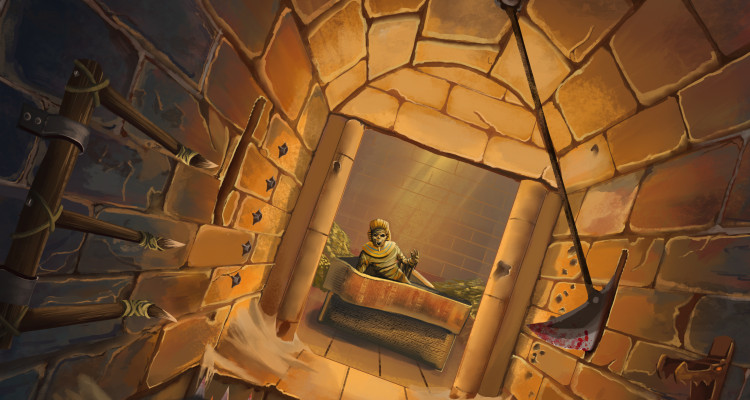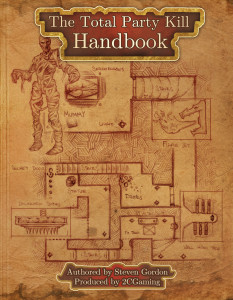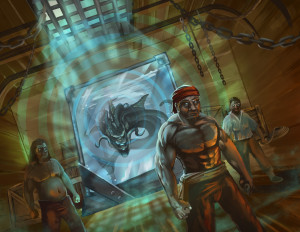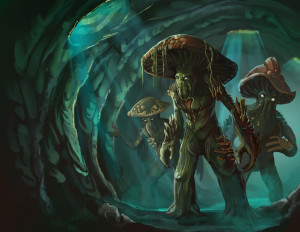Traps come in all sorts of shapes and sizes, more so then we can possibly cover in one article. So when it came to writing about designing traps for D&D, we went the the experts.
Steve Gordon from 2CGaming is the author of The Total Party Kill Handbook: 5th Edition Encounters and Traps, a guide to creating the most unique and challenging encounters. This brand new handbook is a Game Master’s aide, containing twenty-five encounters and a Trap Workshop full of dangerous obstacles that work perfectly in D&D. And clocking in at close to 150 pages, The Total Party Kill Handbook has a ton of content.
How can traps make RPGs more interesting or fun to play?
Steve Gordon: It’s been said that the three core pillars of an RPG are combat, roleplaying, and exploration. Traps, properly used, can facilitate all three. I ran an encounter at Strategicon over labor day weekend that involved an ancient, trap-filled tomb, but with all the traps already triggered.
Each one had left signs of its effects in plain sight, ranging from the obvious scorch marks and the stench of noxious fumes to the more subtle, like a leg bone stuck in a stone brick that had re-solidified after a Stone to Mud spell expired. Every time I ran the encounter, the players were talking amongst themselves, trying to figure out what the traps were and why none of them were active. About halfway in, most groups realized the real trouble wouldn’t be getting to the center of the tomb… it would be getting out alive.
I saw a lot of creative solutions for preventing the traps from re-arming, and a few clever players drawing out the map on a notepad and marking where the traps were in case the dungeon reset them and concealed the evidence (spoilers: it did).
What is the Dungeon Master’s Guide missing that The Total Party Kill Handbook completes?
Steve Gordon: The 5th Edition Dungeon Master’s Guide is an awesome book, but when it comes to traps, especially in comparison to the huge selection of traps and terrain hazards in the 4th edition DMG, it feels very light. There are a few pre-made traps, general guidelines on how much damage traps should do and roughly what the saving throw DCs should be, and a table in the back of the book with a list of trap ideas, but no numbers attached.
The Trap Workshop in the Total Party Kill Handbook aims to fix that. The Trap Workshop is component based, and every component has multiple scaling options with the math done for you. If you ever wondered what the difference is between a 1st level pit trap and a 15th level one, this book will show you. The scaling guidelines will cover DCs and damage for all of the pit’s mechanics at various levels of challenge: how hard is it to spot, to sabotage, and to climb out of, as well as unique additions like whether the trap stays open or closes again after it triggers.
Then you can add other components (from poison gas to webs to dart launchers and more) or special additions we call modifiers (permanent terrain effects, illusions, alarms that call in reinforcements, and so on) and in every case, all the relevant numbers will be provided for the DM. It also includes unique components, like a Trojan Horse, a Portal style dimensional door, and a whole bunch of short and long-term curses.
What Inspired The Total Party Kill Handbook?
Steve Gordon: There are two main parts to The Total Party Kill Handbook, the encounters and the Trap Workshop. For the first part, I wanted to create a book of clever, challenging encounters because as a DM, I have a story I want to tell and a world I want my players to explore, but I don’t always know exactly what challenge should be between points A and B. I want something that’s less than a full adventure module, but more than just a cool idea.
I’ve also thought a lot about which encounters I remember from the games I’ve played in, and they’re almost always the ones that were extremely challenging. The ones that pushed us to our limits, not sure if we’d make it out or not, and we barely managed to pull through. Even when we didn’t, and it was a party wipe, those are the stories that get told and re-told over the years, as long as it felt like we lost a fair fight. Those are the encounters that inspired The Total Party Kill Handbook.
How should DMs use traps in a way that doesn’t make their players paranoid for all of eternity?
Steve Gordon: I think the best way to do it is to avoid invisible traps. A jet of flame in the center of a room that slowly spins in place is interesting, because it dramatically changes the encounter. It forces players to stay mobile, and getting knocked down or slowed is suddenly much worse. Having a hail of arrows hit the party for 15 points of damage because they missed their perception check by a few points is not interesting, it’s just a resource tax to make them use up some of their healing. If the arrow slits are obviously visible, or the trap is magical and fires a volley of arrows every 2 rounds, it gives the party something to talk about and decisions to make.
What were the biggest challenges in creating new traps and how did you overcome them?
Steve Gordon: The biggest challenge was without a doubt coming up with traps that make encounters more interesting, not just longer. Traps that punish bad decisions more than bad dice rolls, or that allow the players to take risks for greater reward. I spent a lot of time reading about existing traps, testing ideas in my ongoing campaigns, and doing a lot of brainstorming with the other DMs on the 2CGaming team. We’d write down twenty trap ideas or so, and then whittle those down to the best four or five. Repeat that process a half-dozen times, and you get a very solid set of traps.
In creating The Total Party Kill Handbook, what have you learned that DMs can use in designing their own traps?
Steve Gordon: Imagine you’re a player, and think about how you would tackle the trap. You want to avoid this scenario: Make a perception check. On a success, make a disarm check. On a failure, save for half of 4d6 damage. If the trap is paired with a combat encounter, you also want to avoid the scenario of the party rogue standing next to the trap rolling skill checks every round. A few general rules I’ve picked up for good trap design are: leave lasting terrain effects, fewer dice rolls are better than many, and traps go well with monsters.
What is your favorite trap that you made in The Total Party Kill Handbook?
Steve Gordon: From a pure comedy perspective, it’s the Disintegration Fake-Out. Best used on veteran players who know that disintegrate means a green beam and a whole lot of dust, this trap is paired with a magically silenced room. As soon as someone touches the door out of the room, an illusory green beam strikes them, they vanish, and a small pile of dust is all that remains. The character finds themselves turned invisible, and for a few hilarious seconds, the party freaks out. Bonus points if you take that player into another room to “talk about making a new character.”
You can find out a lot more about interesting encounters and traps by checking out and supporting his Kickstarter campaign.




